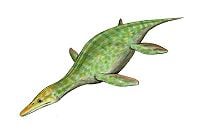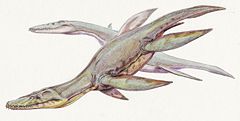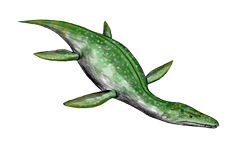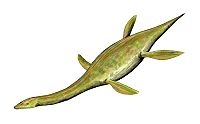Difference between revisions of "Pliosaur" - New World Encyclopedia
Glenn Strait (talk | contribs) |
Rosie Tanabe (talk | contribs) |
||
| (10 intermediate revisions by 4 users not shown) | |||
| Line 1: | Line 1: | ||
| − | {{Copyedited}}{{Approved}}{{Images OK}} | + | {{Ebcompleted}}{{Copyedited}}{{Approved}}{{Images OK}}{{2Copyedited}} |
{{Taxobox | {{Taxobox | ||
| name = Pliosaur | | name = Pliosaur | ||
| Line 16: | Line 16: | ||
see text | see text | ||
}} | }} | ||
| − | '''Pliosaurs''' were carnivorous, aquatic, [[Mesozoic]]-era (251 - 65 million years ago)[[reptile]]s comprising the suborder '''Pliosauroidea''' of the [[Plesiosauria]] order, characterized by a broad body, short tail, | + | '''Pliosaurs''' were carnivorous, aquatic, [[Mesozoic]]-era (251-65 million years ago) [[reptile]]s comprising the suborder '''Pliosauroidea''' of the [[Plesiosauria]] order, characterized by a broad body, short tail, four paddle-shaped flipper limbs, and a shorter neck and more elongated head than the closely related "true [[plesiosaur]]s" (suborder Plesiosauroidea of the Plesiosauria order). They lived during the three periods—[[Triassic]], [[Jurassic]], and [[Cretaceous]]—of the Mesozoic era and, along with the true plesiosaurs, were the largest aquatic animals of their time. They were not [[dinosaur]]s. |
| − | + | {{toc}} | |
| − | Once dominant aquatic creatures, with sharp teeth, massive heads, and bodies up to 15 meters in length (Rincon 2008), the pliosaurs had disappeared by the end of the [[Mesozoic]] era, when a catastrophic [[Mass extinction#Cretaceous-Tertiary extinction event|extinction event]] also ended the | + | Once dominant aquatic creatures, with sharp teeth, massive heads, and bodies up to 15 meters (49 feet) in length (Rincon 2008), the pliosaurs had disappeared by the end of the [[Mesozoic]] era, when a catastrophic [[Mass extinction#Cretaceous-Tertiary extinction event|extinction event]] also ended the [[dinosaur]]s' dominance on land. Furthermore, they may not have left any direct descendants from their lineage. However, in the step-by-step process of the development of the world, the pliosaurs played an important role in the [[food chain]]s of their time, and helped prepare the environment for life today. Furthermore, they continue to live in the [[human]] imagination and add to the wonder of [[life]]. |
{{Mesozoic Footer}} | {{Mesozoic Footer}} | ||
==Overview and description== | ==Overview and description== | ||
| − | |||
===Plesiosauria=== | ===Plesiosauria=== | ||
[[Image:Simolestes1DB.jpg|thumb|240px|right|''[[Simolestes|Simolestes vorax]]'']] | [[Image:Simolestes1DB.jpg|thumb|240px|right|''[[Simolestes|Simolestes vorax]]'']] | ||
| − | The Plesiosauria order, to which the pliosaurs belonged, were aquatic, mostly marine reptiles (superorder Sauroptrygia) with a broad body, short tail, and four paddle-shaped flipper limbs. Plesiosauria first appear in the fossil record in the Middle [[Triassic]]. They thrived until the [[mass extinction#Cretaceous-Tertiary extinction event|K-T extinction]], at the end of the [[Cretaceous]] period. Although they lived at the same time as [[dinosaur]]s, and though they are often lumped together with the "terrible lizards," they were not dinosaurs. | + | The Plesiosauria order, to which the pliosaurs belonged, were aquatic, mostly marine, reptiles (superorder Sauroptrygia) with a broad body, short tail, and four paddle-shaped flipper limbs. Plesiosauria first appear in the fossil record in the Middle [[Triassic]]. They thrived until the [[mass extinction#Cretaceous-Tertiary extinction event|K-T extinction]], at the end of the [[Cretaceous]] period. Although they lived at the same time as [[dinosaur]]s, and though they are often lumped together with the "terrible lizards," they were not dinosaurs. |
| − | The limb arrangement of members of Plesiosauria is unusual in aquatic animals and it is thought that | + | The limb arrangement of members of Plesiosauria is unusual in aquatic animals and it is thought that the limbs were used to propel the animal through the water by a combination of rowing movements and up-and-down movements. Members of Plesiosauria had no tail fin and the tail was most likely used for helping in directional control. This arrangement is in contrast to that of the later [[mosasaur]]s and the earlier [[ichthyosaur]]s. There may be similarities with the method of swimming used by penguins and [[turtle]]s, which respectively have two and four flipper-like limbs. |
| − | As a group, the plesiosaurs were the largest aquatic animals of their time, and even the smallest were about two meters (6.5 feet) long. They grew to be considerably larger than the largest giant [[crocodile]]s, and were bigger than their successors, the | + | As a group, the plesiosaurs were the largest aquatic animals of their time, and even the smallest were about two meters (6.5 feet) long. They grew to be considerably larger than the largest giant [[crocodile]]s, and were bigger than their successors, the [[mosasaur]]s. However, their predecessors as rulers of the sea, the [[dolphin]]-like [[ichthyosaur]]s, are known to have reached 23 meters (m) in length, and the modern whale [[shark]] (18 m), sperm [[whale]] (20 m), and especially the blue whale (30 m) have produced considerably larger specimens. |
| − | The anteriorly placed internal nostrils have palatal grooves to channel water, the flow of which would be maintained by hydrodynamic pressure over the posteriorly placed external nares during locomotion. During its passage through the nasal ducts, the water would have been "tasted" by olfactory epithelia. | + | The anteriorly placed internal nostrils have [[palate|palatal]] grooves to channel water, the flow of which would be maintained by hydrodynamic pressure over the posteriorly placed external [[nares]] during locomotion. During its passage through the nasal ducts, the water would have been "tasted" by [[olfactory]] [[epithelia]]. |
| − | The Plesiosauria order is divided into two suborders, Pliosauroidea and Plesiosauroidea. Members of the Plesiosauria order in general are sometimes called | + | The Plesiosauria order is divided into two suborders, Pliosauroidea and Plesiosauroidea. Members of the Plesiosauria order in general are sometimes called [[plesiosaur]]s, as are members of the suborder Plesiosauroidea. The term "true plesiosaurs" can be applied to those belonging to the suborder Plesiosauroidea in order to distinguish them. Members of the Pliosauroidea suborder are known as pliosaurs. |
===Pliosaurs=== | ===Pliosaurs=== | ||
[[image:Rhomaleosaurus_BW.jpg|thumb|right|240px|''[[Rhomaleosaurus]]'']] | [[image:Rhomaleosaurus_BW.jpg|thumb|right|240px|''[[Rhomaleosaurus]]'']] | ||
| − | The Pliosauroidea and Plesiosauroidea are primarily distinguished by head and neck size. The Plesiosauroidea, such as Cryptoclididae, Elasmosauridae, and Plesiosauridae, had long necks and may have been bottom-feeders, in shallow waters | + | The Pliosauroidea and Plesiosauroidea are primarily distinguished by head and neck size. The Plesiosauroidea, such as Cryptoclididae, Elasmosauridae, and Plesiosauridae, had long necks and may have been bottom-feeders, in shallow waters. The Pliosauridae (pliosaurs) had a short neck with large, elongated head and may have been at home in deeper waters. However, in recent classifications, one short-necked and large-headed [[Cretaceous]] group, the Polycotylidae, are included under the Plesiosauroidea, rather than under the traditional Pliosauroidea. |
| − | In addition to the shorter neck and more elongated head, pliosaurs also were more crocodile-shaped than the members of Plesiosauroidea. | + | In addition to the shorter neck and more elongated head, pliosaurs also were more crocodile-shaped than the members of Plesiosauroidea. The pliosaurs' long and powerful jaws carried many sharp, conical teeth. Pliosaur fossils indicated a range from four to fifteen meters in length, with an average of five to six meters (16 to 20 feet)(NHM 2007). In 2006, a fossil was found on the Arctic island chain of Svalbard of Norway of a [[Jurassic]] era pliosaur estimated at fifteen meters (50 feet) from nose to tail (Rincon 2008). Its flipper alone measured three meters in length. This fossil is 20 percent larger than the previously largest pliosaur (genus ''Kronosaurus'') of 10 to 11 meters long found in [[Australia]] (NHM 2007; Rincon 2008). Pliosaurs are considered to have larger, more powerful muscles than a crocodile, and huge, robust jaws (Rincon 2008). |
| − | Pliosaurs were [[Carnivore|carnivorous]] and their prey may have included [[fish]], [[ichthyosaur]]s, and other plesiosaurs. | + | Pliosaurs were [[Carnivore|carnivorous]], and their prey may have included [[fish]], [[ichthyosaur]]s, and other plesiosaurs. Their carnivorous abilities were described by two paleontologist announcing the find of the largest pliosaur: "Think of an animal as long as a bus with teeth larger than cucumbers. Now think that those teeth are contained in a head that could swallow an adult whole" (Knight 2006). Another paleontologist stated "a large pliosaur was big enough to pick up a small car in its jaws and bite it in half" (Rincon 2008). |
| − | The adaptation of having four-flippers remains a mystery. No modern animals have this swimming adaptation, so there is considerable speculation about what kind of stroke they used. The short-necked pliosaurs ( | + | The adaptation of having four-flippers remains a mystery. No modern animals have this swimming adaptation, so there is considerable speculation about what kind of stroke they used. The short-necked pliosaurs (for example, ''Liopleurodon'') may have been fast swimmers, unlike their pliosaurian cousins, the long-necked true plesiosaurs, which (with the exception of the Polycotylidae) were built more for maneuverability than for speed, and were probably relatively slow swimmers. |
Plesiosaurs, in general, trace roughly from about 210 million years ago to about 65 million years ago (Knight 2006). Fossil specimens of pliosaurs have been found in [[England]], [[Mexico]], [[South America]], [[Australia]], and the [[Arctic]] region near [[Norway]]. The name is derived from the [[Ancient Greek|Greek]] ''πλειω'' from the verb meaning "to sail" or ''πλειων'' meaning "fin" and ''σαυρος'' meaning "lizard." | Plesiosaurs, in general, trace roughly from about 210 million years ago to about 65 million years ago (Knight 2006). Fossil specimens of pliosaurs have been found in [[England]], [[Mexico]], [[South America]], [[Australia]], and the [[Arctic]] region near [[Norway]]. The name is derived from the [[Ancient Greek|Greek]] ''πλειω'' from the verb meaning "to sail" or ''πλειων'' meaning "fin" and ''σαυρος'' meaning "lizard." | ||
| − | Pliosaurs originally included were reptiles of the family Pliosauridae, but several other genera and families are now also included | + | Pliosaurs originally included were reptiles of the family Pliosauridae, but several other genera and families are now also included with the number and details of which varying according to the classification used. Typical genera include ''[[Macroplata]],'' ''[[Kronosaurus]],'' ''[[Liopleurodon]],'' ''[[Pliosaurus]],'' and ''[[Peloneustes]]''. Many very early (from the [[Rhaetian]] (Latest Triassic) and [[Early Jurassic]]) primitive pliosaurs were very like plesiosaurs in appearance and indeed used to be included in the family [[Plesiosauridae]]. |
==Taxonomy== | ==Taxonomy== | ||
| Line 88: | Line 87: | ||
* Carpenter, K. 1996. A review of short-necked plesiosaurs from the Cretaceous of the western interior, North America. ''Neues Jahrbuch fuer Geologie und Palaeontologie Abhandlungen'' (Stuttgart) 201(2): 259-287. | * Carpenter, K. 1996. A review of short-necked plesiosaurs from the Cretaceous of the western interior, North America. ''Neues Jahrbuch fuer Geologie und Palaeontologie Abhandlungen'' (Stuttgart) 201(2): 259-287. | ||
* Everhart, M. J. 2002. Where the elasmosaurs roam. ''Prehistoric Times'' 53: 24-27. | * Everhart, M. J. 2002. Where the elasmosaurs roam. ''Prehistoric Times'' 53: 24-27. | ||
| − | * Knight, S. 2006. [http://www.timesonline.co.uk/article/0,,3-2390350,00.html T. Rex of the oceans found, with teeth like cucumbers] ''Times On Line'' | + | * Knight, S. 2006. [http://www.timesonline.co.uk/article/0,,3-2390350,00.html T. Rex of the oceans found, with teeth like cucumbers.] ''Times On Line'' October 5, 2006. Retrieved April 21, 2008. |
| − | * Naturhistorisk Museum (NHM). 2007. [http://www.nhm.uio.no/pliosaurus/english The monster is even bigger than earlier estimates] ''Naturhistorisk Museum, University of Oslo''. Retrieved April 21, 2008. | + | * Naturhistorisk Museum (NHM). 2007. [http://www.nhm.uio.no/pliosaurus/english The monster is even bigger than earlier estimates.] ''Naturhistorisk Museum, University of Oslo''. Retrieved April 21, 2008. |
| − | * O'Keefe, F. R. 2001. A cladistic analysis and taxonomic revision of the Plesiosauria (Reptilia: Sauropterygia). ''Acta Zoologica Fennica'' 213: 1-63. | + | * O'Keefe, F.R. 2001. A cladistic analysis and taxonomic revision of the Plesiosauria (Reptilia: Sauropterygia). ''Acta Zoologica Fennica'' 213: 1-63. |
| − | * Rincon, P. 2008. [http://news.bbc.co.uk/2/hi/science/nature/7264856.stm Sea reptile is biggest on record] ''BBC News'' | + | * Rincon, P. 2008. [http://news.bbc.co.uk/2/hi/science/nature/7264856.stm Sea reptile is biggest on record] ''BBC News'' February 27, 2008. Retrieved April 21, 2008. |
* White, T. 1935. On the skull of ''Kronosaurus queenslandicus'' Longman. ''Occasional Papers Boston Soc. Nat. Hist.'' 8: 219-228. | * White, T. 1935. On the skull of ''Kronosaurus queenslandicus'' Longman. ''Occasional Papers Boston Soc. Nat. Hist.'' 8: 219-228. | ||
==External links== | ==External links== | ||
| + | All links retrieved November 24, 2022. | ||
| − | *[http:// | + | *[http://plesiosauria.com/classification/pliosauroidea/ The Plesiosaur Directory--pliosaur page.] |
Latest revision as of 08:04, 24 November 2022
| Pliosaur
| ||||||||||||
|---|---|---|---|---|---|---|---|---|---|---|---|---|
 Peloneustes philarchus
| ||||||||||||
| Scientific classification | ||||||||||||
| ||||||||||||
|
see text |
Pliosaurs were carnivorous, aquatic, Mesozoic-era (251-65 million years ago) reptiles comprising the suborder Pliosauroidea of the Plesiosauria order, characterized by a broad body, short tail, four paddle-shaped flipper limbs, and a shorter neck and more elongated head than the closely related "true plesiosaurs" (suborder Plesiosauroidea of the Plesiosauria order). They lived during the three periods—Triassic, Jurassic, and Cretaceous—of the Mesozoic era and, along with the true plesiosaurs, were the largest aquatic animals of their time. They were not dinosaurs.
Once dominant aquatic creatures, with sharp teeth, massive heads, and bodies up to 15 meters (49 feet) in length (Rincon 2008), the pliosaurs had disappeared by the end of the Mesozoic era, when a catastrophic extinction event also ended the dinosaurs' dominance on land. Furthermore, they may not have left any direct descendants from their lineage. However, in the step-by-step process of the development of the world, the pliosaurs played an important role in the food chains of their time, and helped prepare the environment for life today. Furthermore, they continue to live in the human imagination and add to the wonder of life.
| Mesozoic era (251 - 65 mya) | ||
|---|---|---|
| Triassic | Jurassic | Cretaceous |
Overview and description
Plesiosauria
The Plesiosauria order, to which the pliosaurs belonged, were aquatic, mostly marine, reptiles (superorder Sauroptrygia) with a broad body, short tail, and four paddle-shaped flipper limbs. Plesiosauria first appear in the fossil record in the Middle Triassic. They thrived until the K-T extinction, at the end of the Cretaceous period. Although they lived at the same time as dinosaurs, and though they are often lumped together with the "terrible lizards," they were not dinosaurs.
The limb arrangement of members of Plesiosauria is unusual in aquatic animals and it is thought that the limbs were used to propel the animal through the water by a combination of rowing movements and up-and-down movements. Members of Plesiosauria had no tail fin and the tail was most likely used for helping in directional control. This arrangement is in contrast to that of the later mosasaurs and the earlier ichthyosaurs. There may be similarities with the method of swimming used by penguins and turtles, which respectively have two and four flipper-like limbs.
As a group, the plesiosaurs were the largest aquatic animals of their time, and even the smallest were about two meters (6.5 feet) long. They grew to be considerably larger than the largest giant crocodiles, and were bigger than their successors, the mosasaurs. However, their predecessors as rulers of the sea, the dolphin-like ichthyosaurs, are known to have reached 23 meters (m) in length, and the modern whale shark (18 m), sperm whale (20 m), and especially the blue whale (30 m) have produced considerably larger specimens.
The anteriorly placed internal nostrils have palatal grooves to channel water, the flow of which would be maintained by hydrodynamic pressure over the posteriorly placed external nares during locomotion. During its passage through the nasal ducts, the water would have been "tasted" by olfactory epithelia.
The Plesiosauria order is divided into two suborders, Pliosauroidea and Plesiosauroidea. Members of the Plesiosauria order in general are sometimes called plesiosaurs, as are members of the suborder Plesiosauroidea. The term "true plesiosaurs" can be applied to those belonging to the suborder Plesiosauroidea in order to distinguish them. Members of the Pliosauroidea suborder are known as pliosaurs.
Pliosaurs
The Pliosauroidea and Plesiosauroidea are primarily distinguished by head and neck size. The Plesiosauroidea, such as Cryptoclididae, Elasmosauridae, and Plesiosauridae, had long necks and may have been bottom-feeders, in shallow waters. The Pliosauridae (pliosaurs) had a short neck with large, elongated head and may have been at home in deeper waters. However, in recent classifications, one short-necked and large-headed Cretaceous group, the Polycotylidae, are included under the Plesiosauroidea, rather than under the traditional Pliosauroidea.
In addition to the shorter neck and more elongated head, pliosaurs also were more crocodile-shaped than the members of Plesiosauroidea. The pliosaurs' long and powerful jaws carried many sharp, conical teeth. Pliosaur fossils indicated a range from four to fifteen meters in length, with an average of five to six meters (16 to 20 feet)(NHM 2007). In 2006, a fossil was found on the Arctic island chain of Svalbard of Norway of a Jurassic era pliosaur estimated at fifteen meters (50 feet) from nose to tail (Rincon 2008). Its flipper alone measured three meters in length. This fossil is 20 percent larger than the previously largest pliosaur (genus Kronosaurus) of 10 to 11 meters long found in Australia (NHM 2007; Rincon 2008). Pliosaurs are considered to have larger, more powerful muscles than a crocodile, and huge, robust jaws (Rincon 2008).
Pliosaurs were carnivorous, and their prey may have included fish, ichthyosaurs, and other plesiosaurs. Their carnivorous abilities were described by two paleontologist announcing the find of the largest pliosaur: "Think of an animal as long as a bus with teeth larger than cucumbers. Now think that those teeth are contained in a head that could swallow an adult whole" (Knight 2006). Another paleontologist stated "a large pliosaur was big enough to pick up a small car in its jaws and bite it in half" (Rincon 2008).
The adaptation of having four-flippers remains a mystery. No modern animals have this swimming adaptation, so there is considerable speculation about what kind of stroke they used. The short-necked pliosaurs (for example, Liopleurodon) may have been fast swimmers, unlike their pliosaurian cousins, the long-necked true plesiosaurs, which (with the exception of the Polycotylidae) were built more for maneuverability than for speed, and were probably relatively slow swimmers.
Plesiosaurs, in general, trace roughly from about 210 million years ago to about 65 million years ago (Knight 2006). Fossil specimens of pliosaurs have been found in England, Mexico, South America, Australia, and the Arctic region near Norway. The name is derived from the Greek πλειω from the verb meaning "to sail" or πλειων meaning "fin" and σαυρος meaning "lizard."
Pliosaurs originally included were reptiles of the family Pliosauridae, but several other genera and families are now also included with the number and details of which varying according to the classification used. Typical genera include Macroplata, Kronosaurus, Liopleurodon, Pliosaurus, and Peloneustes. Many very early (from the Rhaetian (Latest Triassic) and Early Jurassic) primitive pliosaurs were very like plesiosaurs in appearance and indeed used to be included in the family Plesiosauridae.
Taxonomy
The taxonomy presented here is mainly based on the plesiosaur cladistic analysis proposed by O'Keefe in 2001.
- Suborder: †Pliosauroidea Welles, 1943 sensu O'Keefe, 2001
- ? †Bishanopliosaurus Dong, 1980
- ? †Megalneusaurus Knight, 1898
- ? †Pachycostasaurus Cruickshank, Martill & Noe, 1996
- ? †Sinopliosaurus G. Young, 1820
- †Thalassiodracon Storrs & Taylor, 1996
- †Archaeonectrus Novozhilov, 1964
- †Attenborosaurus Bakker, 1993
- †Eurycleidus Andrews, 1922
- Family: †Rhomaleosauridae (Nopsca, 1928) Kuhn, 1961 sensu O'Keefe,2001
- †Umoonasaurus Kear, Schroeder & Lee, 2006
- ? †Yuzhoupliosaurus Zhang, 1985
- ? †Hexatarostinus
- †Rhomaleosaurus Seeley, 1874
- †Simolestes Andrews, 1909
- Family: †Leptocleididae White, 1940
- †Leptocleidus Andrews, 1922
- Family: †Pliosauridae Seeley, 1874 sensu O'Keefe, 2001
- ? †Plesiopleurodon Carpenter, 1996
- ? †Polyptychodon Non Owen, 1841
- ? †Maresaurus Gasparini, 1997
- †Macroplata Swinton, 1930
- †Hauffiosaurus O’Keefe, 2001
- †Kronosaurus Longman, 1924
- †Peloneustes Lydekker, 1889
- †Liopleurodon Sauvage, 1873
- †Brachauchenius Williston, 1903
- †Pliosaurus Owen, 1841
ReferencesISBN links support NWE through referral fees
- Carpenter, K. 1996. A review of short-necked plesiosaurs from the Cretaceous of the western interior, North America. Neues Jahrbuch fuer Geologie und Palaeontologie Abhandlungen (Stuttgart) 201(2): 259-287.
- Everhart, M. J. 2002. Where the elasmosaurs roam. Prehistoric Times 53: 24-27.
- Knight, S. 2006. T. Rex of the oceans found, with teeth like cucumbers. Times On Line October 5, 2006. Retrieved April 21, 2008.
- Naturhistorisk Museum (NHM). 2007. The monster is even bigger than earlier estimates. Naturhistorisk Museum, University of Oslo. Retrieved April 21, 2008.
- O'Keefe, F.R. 2001. A cladistic analysis and taxonomic revision of the Plesiosauria (Reptilia: Sauropterygia). Acta Zoologica Fennica 213: 1-63.
- Rincon, P. 2008. Sea reptile is biggest on record BBC News February 27, 2008. Retrieved April 21, 2008.
- White, T. 1935. On the skull of Kronosaurus queenslandicus Longman. Occasional Papers Boston Soc. Nat. Hist. 8: 219-228.
External links
All links retrieved November 24, 2022.
Credits
New World Encyclopedia writers and editors rewrote and completed the Wikipedia article in accordance with New World Encyclopedia standards. This article abides by terms of the Creative Commons CC-by-sa 3.0 License (CC-by-sa), which may be used and disseminated with proper attribution. Credit is due under the terms of this license that can reference both the New World Encyclopedia contributors and the selfless volunteer contributors of the Wikimedia Foundation. To cite this article click here for a list of acceptable citing formats.The history of earlier contributions by wikipedians is accessible to researchers here:
The history of this article since it was imported to New World Encyclopedia:
Note: Some restrictions may apply to use of individual images which are separately licensed.




